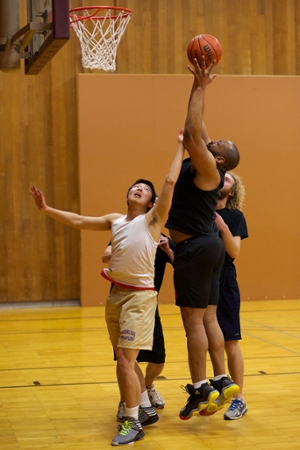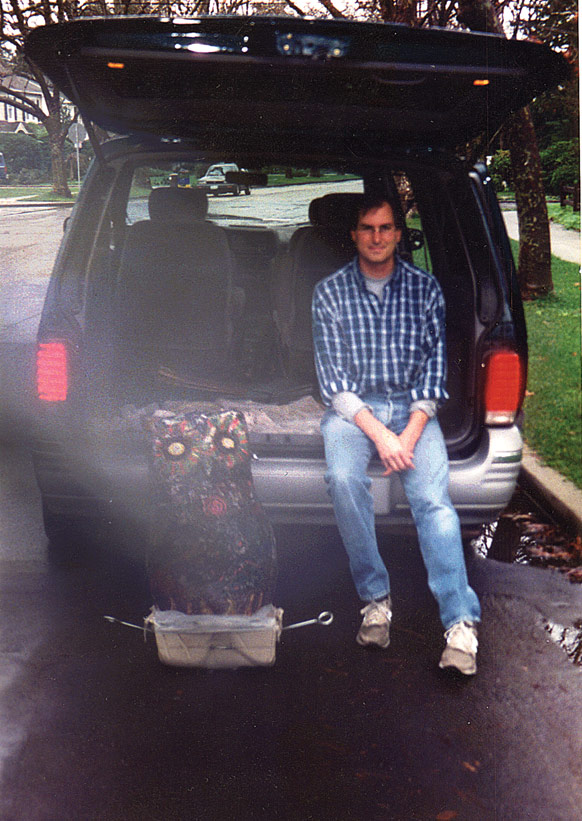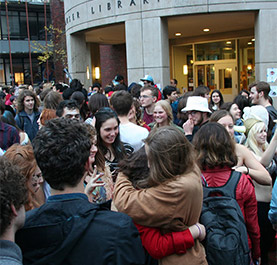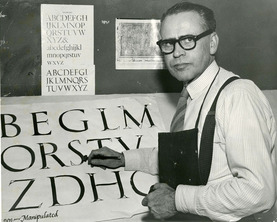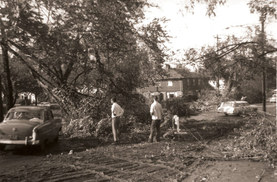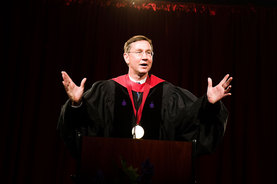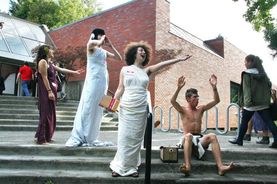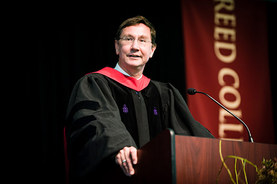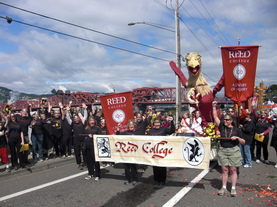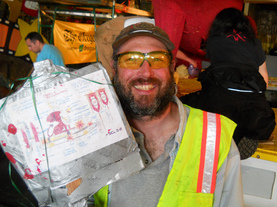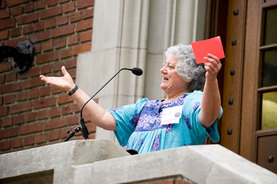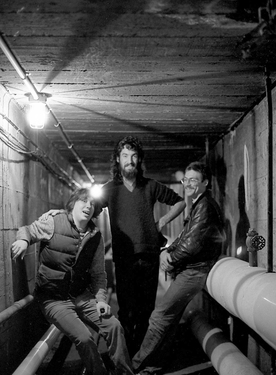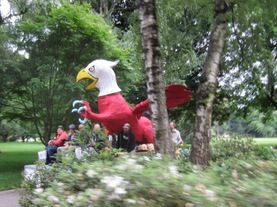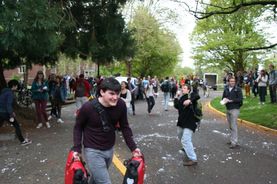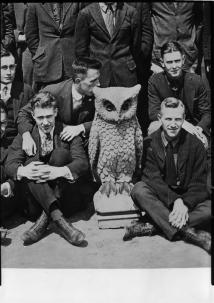
IRIS login | Reed College home Volume 96, No. 2: June 2017
Tags
"traditions"
Great Pumpkin Appears in President’s Office

Vast. Vegetative. Vibrantly orange. President Kroger admires the gargantuan gourd bestowed upon him by a fleet-footed band of students.
An enormous pumpkin materialized in the office of President John R. Kroger last week, courtesy of a fleet-footed band of Reed students who wheeled the gargantuan gourd in on a handcart, installed it in the presidential suite, and promptly abstracted themselves from view.
Details of the shadowy operation remain unclear, but it appears that the stupendous squash—which weighs well over 100 pounds—was raised on the Flamingo Ridge Farm and resided in Commons for some time before its great migration to Eliot Hall. Students penned messages of holiday cheer on the colossal cucurbit, which now graces the president's coffee table.
The students also deposited a great pumpkin at the door of Community Safety Director Gary Granger in 28 West. Granger and his crew subsequently carved a face into the fleshy fruit and turned it into--what else?-- a gigantic Jack-o'-lantern.
Continue reading Great Pumpkin Appears in President’s Office
Young Alumni Triumph in “March Madness” Tourney
Alumni dominated Reed’s annual March Madness basketball tournament last week as Just Blasé (composed of younger alumni) edged out the Has-Beens (older students) 30-26 in a hard-fought final match.
Now in its 26th year, the madcap single-elimination tournament features eight teams, composed of students, alumni, professors, and staff. Some players show considerable skill, others haven’t touched a ball in years. It’s not uncommon to see teams fielded by dorms, academic departments, the Ultimate Frisbee team, or the rugby team. The combination of wildly different levels of talent makes for exciting games, which progress from fun and sloppy to tense and skilled as the tournament moves into its final rounds.
There are some unique rules, too, that add elements of unpredictability to March Madness, including a running game clock, meaning that play is never stopped during the 12-minute halves, and the three-foul-limit per player, which requires any player who commits three fouls to leave the game immediately. This can cause teams to have to play with less than five players, if too many of their players foul out.
Continue reading Young Alumni Triumph in “March Madness” Tourney
Steve and the Owl
In the winter of 1996–97, a band of Reed students including Justin Campbell ’99 and Colin McCluney ’99 took the Doyle Owl on a road trip to California. On a whim, they stopped by Steve Jobs' house in Palo Alto and rang the bell. They were floored when Steve emerged, admired the Owl, talked about Reed, and posed for this photo in Justin’s parents’ minivan. “He was really nice about it,” Justin says.
Continue reading Steve and the Owl
March Madness at Reed—Yes, Reed
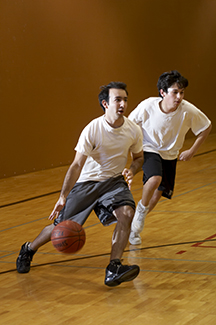
High fashion and devious fakery abound at Reed's March Madness (Photo from 2005). Photo by Orin Bassoff
Reedies packed the sports center on March 15 for an event they had been waiting for all spring. This wasn’t part of RAW, Reed’s annual arts week; it was a very different type of exhibition—March Madness.
Although March Madness at Reed may not feature as many teams—or as much advertising—as the NCAA version, its passion and intensity are unrivaled. This year marked the event’s 25th anniversary, and it showed in the approximately 200 spectators, participants, and supporters alike, who came out to watch the fun.
March Madness is a one-night, single-elimination tournament, featuring eight teams, compiled of Reed students, alumni, professors, and staff. The contest has its origins in 1989 when the Reed student team, which included Erik Brakstad ’89, was clobbered by a team made up of professors. “I thought to myself, where else would the student team lose to the faculty?” Erik said. He founded the tournament as a chance to get even for the loss, and the mania has only mounted since then.
Continue reading March Madness at Reed—Yes, Reed
Spring Fall Thesis Parade is a Soggy Success
Portland can be a bit gloomy this time of year, when unremitting rain provides the soundtrack for what can seem like unending final's work. But those grey skies couldn't dampen the spirit of the spring-fall thesis parade, which was celebrated last week in a particularly heartwarming bout of collective effervescence.
Bedecked in colorful costumes and covered in glitter, students danced and hugged each other to the beat of Reed’s drum corps. About 30 seniors hurled their thesis drafts on the bonfire in front of the library as classmates sprayed them with champagne (thankfully the temperature did not dip below the mid 50s).
Continue reading Spring Fall Thesis Parade is a Soggy Success
Calligraphy Makes a Comeback
"Concentrate on your breath and you'll make a better looking L. Breathe in. Breathe out on the downward stroke."
Nearly 30 students, faculty, and alumni hold their Speedball pens at a 45-degree angle and exhaling, grab the baseline with a downward stroke and finish with an exit serif. Next up is the letter O.
"As the O goes, so goes the alphabet," says calligraphy instructor Inga Dubay. "You'll be glad we didn't start with the O, it's not the easiest of letters. But it is a very lovely one in Italic. In handwriting we do the O all in one stroke, but in calligraphy we do a two-stroke O. Please do not do more than three at one time. You will be ill if you do."
Continue reading Calligraphy Makes a Comeback
Columbus Day Storm - 50 Years Later
The Columbus Day Storm is generally reckoned to be the most powerful extratropical cyclone to hit the United States in the 20th century. Starting October 12, 1962, with peak gusts of 100 miles per hour, it rampaged through California, Oregon, Washington, and British Columbia, killing 23 people, destroying 84 homes, severely damaging 5,000 more, and wreaking overall havoc estimated at $170 million.
What's this got to do with Reed? Nothing, except that the storm has sometimes been attributed to divine retribution after Reed defeated Columbia Christian College that day 19–7 on the football field.
Continue reading Columbus Day Storm - 50 Years Later
Kroger Inaugurated—with <i>Iliad</i>
Amid the call of bagpipes and the flourish of horns, roughly 1,500 people descended on campus on Friday to welcome John R. Kroger as Reed's 15th president. Under the big top on the great lawn, Roger Perlmutter '73, chair of the board of trustees, invested Kroger with the trappings of office—including a copy of the Iliad and a bottle of spring water drawn from the Reed Canyon—in a grand inauguration ceremony.
Student body president Brian Moore '13 hailed Kroger as "the ultimate prospie" for his infectious enthusiasm for all things Reed and for enrolling in Hum 110.
Continue reading Kroger Inaugurated—with <i>Iliad</i>
Johnson Creek Art Show
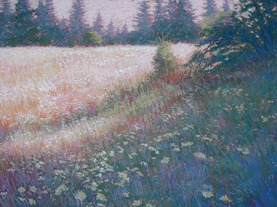
Gary Michael, Powell Butte, pastel
Reed is hosting a cool show of art inspired by Johnson Creek and its tributary, Crystal Springs, which issues forth from the Canyon.
Check out the art on display in Vollum Lounge until October 12, 2012.
Continue reading Johnson Creek Art Show
"Libations!" They Cried
Monday morning, 8:45 a.m. First day of class. As the new crop of freshlings streamed towards Vollum for their first real Hum lecture, laden with backpacks, and clutching coffee cups and water bottles, they were greeted by an unusual spectacle: a veritable pantheon of Greek gods hooting and hollering on the steps outside the lecture hall.
"Libations!" cried the gods. "Libations to honor mighty Zeus!"
Continue reading "Libations!" They Cried
Convoking the Muse
Students, parents, and professors descended in their multitudes upon the Great Lawn on Wednesday for Convocation 2012. Under the billowing big top, 358 newly-minted Reedies were formally inducted into the tribe by an equally fresh president: John Kroger kicked off the ceremony with his first public address as head of the college. Kroger remarked that what he has been struck most by in his first eight weeks cannot be conveyed in a brochure: "Reed is one of the warmest kindest, most welcoming institutions I have ever experienced," he said. "It feels like home."
Home may now be Anna Mann or Foster-Scholz for new students, but they came from all over the globe to get here. Keith Todd, dean of admission, laid out the impressive pilgrimage; students hailed from China, Kenya, New Mexico, and Jakarta, among others. They include more Texans than Minnesotans, several Nicholases and Katherines, not to mention a Thor and a Zeus.
Continue reading Convoking the Muse
Reed Griffin is Rose Parade Royalty
Six-inches high and stuffed with cotton, a griffin sits atop a few worn books stacked on the cluttered desk of Mike Teskey, director of alumni & parent relations. For years this figurine—a plush model of the mythical creature, half lion, half eagle, which Reed takes as its mascot—had fixed its glassy eye on Mike while he worked, and it must have made an impression, because when he walked into the office of the Portland Rose Festival representative to discuss what Reed's float would look like in the upcoming parade, Mike had the stuffed griffin in his hand.
The last time Reed entered a float in the Grand Floral Parade was in 1936. From time to time, alumni would broach the dream of returning to the parade, but like a lot of great ideas, they never got past the broaching stage. Then, at a centennial apple-pressing party in the canyon orchard, Mike struck up a conversation with Jon-Paul Davis '93 and mechanical wizard Rob Mack '93. Rob was the natural choice to spearhead the project; during his Reed days he turned an old Nissan into the infamous Mobile Outdoor Plush Super Upholstered Den (MOSPUD), a mobile beverage-distribution system that graced several Renn Fayres. Rob signed on as Reed's construction leader for the 2012 parade with just one demand: Reed would build the float.
Continue reading Reed Griffin is Rose Parade Royalty
Students Build Bench out of Fallen Doug Fir
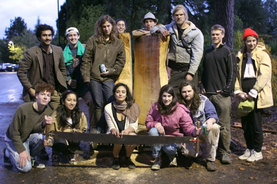
As the sun sets on a wet Friday afternoon, students painstakingly finish sawing the archaic log in half. Photos by Alexi Horowitz '13.
Check out the video by Alexi Horowitz '13
Sawdust flew, chips piled up on the ground, and a sweet piney scent permeated the air as the crosscut gnashed its way through the log. The tree was a Douglas fir that had presided over the Great Lawn, right behind the softball backstop, for 130 years. As the story goes, the 100-foot tree fell during the snowy winter of '09, exposing the decayed roots that caused its downfall.
But the tree's story was not over. Marie Perez '12 got the idea to craft a bench out of a giant section of the trunk. She and other Reedies undertook the mammoth task of using a four-foot crosscut saw (old-timey two-person logging saw) to cut the log in half. Students were invited every evening of finals week to put their studying on hold and come out to the west parking lot to help slice the wood. Over 40 students and staff members turned out to help fashion the trunk into a (very) solid bench for all to sit on. It took about 17 hours of solid sawing to completely halve the log.
Continue reading Students Build Bench out of Fallen Doug Fir
Fanfayre honors history and achievement
Reunions 2012 traveled backward and forward through time at the Fanfayre ceremony celebrating outstanding alumni, staff, and faculty.
John Sheehy '82 presented his the epic oral history of Reed College, Comrades of the Quest, an volume of "almost biblical" dimensions that was, he said, the closest thing Reed has to scripture. Despite its size, he noted that the "director's cut" would be about 30-percent longer: "Reedies appear almost incapable of expressing themselves in a single sentence when a full paragraph—or a full dissertation—will do just as well."
Continue reading Fanfayre honors history and achievement
Sweating It out in the Steam Tunnels
Dimly lit pathways, dusty pipes, graffiti, and intense humidity. At Reed, that could mean one place on campus—the steam tunnels.
One of the attractions during Reunions: Reedfayre '12 was a tour of Reed's mysterious steam tunnels by the Physical Plant's own Steve Yeadon. The labyrinthine route, which made one feel like Indiana Jones on a dangerous mission, started from the basement of Physical Plant, where two gigantic boilers (usually fired by gas, but sometimes by oil, if gas is too expensive) generate the steam that gives the tunnels their purpose.
The tour then wound its way through the depths of Reed, as visitors took care not to bump into the cobwebbed walls or pipes. The abundant graffiti on the pipes, preserved through the years (because as one alum mentioned, the pipes were the only things not whitewashed over for commencement every year), proved highly entertaining.
Continue reading Sweating It out in the Steam Tunnels
Griffin to Make Triumphant Return to Rose Parade
After more than 75 years' absence, a Reed College float will once again join the Portland Rose Festival's Grand Floral Parade, taking place this Saturday, June 9.
Reed first entered a float into the Rose Parade in 1936; although Reedies have played many important roles in the festival since, our beloved institution has never again been represented by its own float.
Continue reading Griffin to Make Triumphant Return to Rose Parade
The Pelting of the Freshmen
Eliot Circle erupted in a flurry of snowballs this morning as upperclassmen enacted a relatively new tradition, the Pelting of the Freshmen, after the final Hum 110 lecture of the academic year.
Unidentified upperclassmen (rumored to include Seth Douglas '13 and Jeremy Lawrence '12) drove a pickup truck to Mount Hood, loaded the bed with snow, and lay in wait for the unwary freshlings to emerge from Vollum. Cheers rent the air as the youngsters streamed down the steps and the icy fusillade commenced.
Continue reading The Pelting of the Freshmen
KRRC Forsakes Terrestrial Broadcast
Two semesters ago, I was DJ at KRRC. Broadcast on Friday afternoons, "Get Naked Radio"--a showcase of electronic dance music that my friends and I put together every week--was slotted between several hours of dead air. This came as a bit of a surprise to us, as we initially believed Friday afternoons, sandwiched between my last class in Eliot Hall and dinner at Commons--was "prime time" for KRRC. Right.
As the semester unfolded, we began to grasp the hard truth that no one was listening. Even on days when the transmitter was functioning properly, our broadcasting radius barely extended beyond the library. And those who would hypothetically listen to Get Naked Radio--our friends--were usually sitting on the beat-up couches strewn across the radio station.
So I was sad but hardly surprised when KRRC terminated its 100-watt terrestrial broadcast last year. In fact, November 30, 2011 marked the last day that KRRC broadcast on the FM dial. Reed has since donated its FM license to the non-profit grassroots group Common Frequency.The move came at the heels of a year-long saga that ultimately ended in KRRC losing its frequency (97.9) to KRNQ, a commercial alternative rock station owned by Cumulus Media. This was the third time KRRC had been bumped from its frequency by a commercial station. (For context: commercial stations can essentially "overtake" KRRC's frequency because of their high power broadcasting license. KRRC's broadcasting license, a secondary-service license phased out by the FCC in 1978, only allows for a broadcast radius the size of campus, if not smaller.)
Continue reading KRRC Forsakes Terrestrial Broadcast
Olde Reed: Was It Better?
It's a cry familiar to freshmen from every decade of Reed's existence: "You're doing what? Hah! Back at Olde Reed..."
Yes, it's Olde Reed! That elusive golden age in which classes were harder, Renn Fayres were crazier, laurels were shinier, and hijinks were, er, jinkier. Olde Reed was always dead by your freshman year, unless you are telling the story, in which case it was dead by your listeners' freshman year. It was epic, it was extraordinary, and it was, in whatever indescribable fashion, better.
Continue reading Olde Reed: Was It Better?

